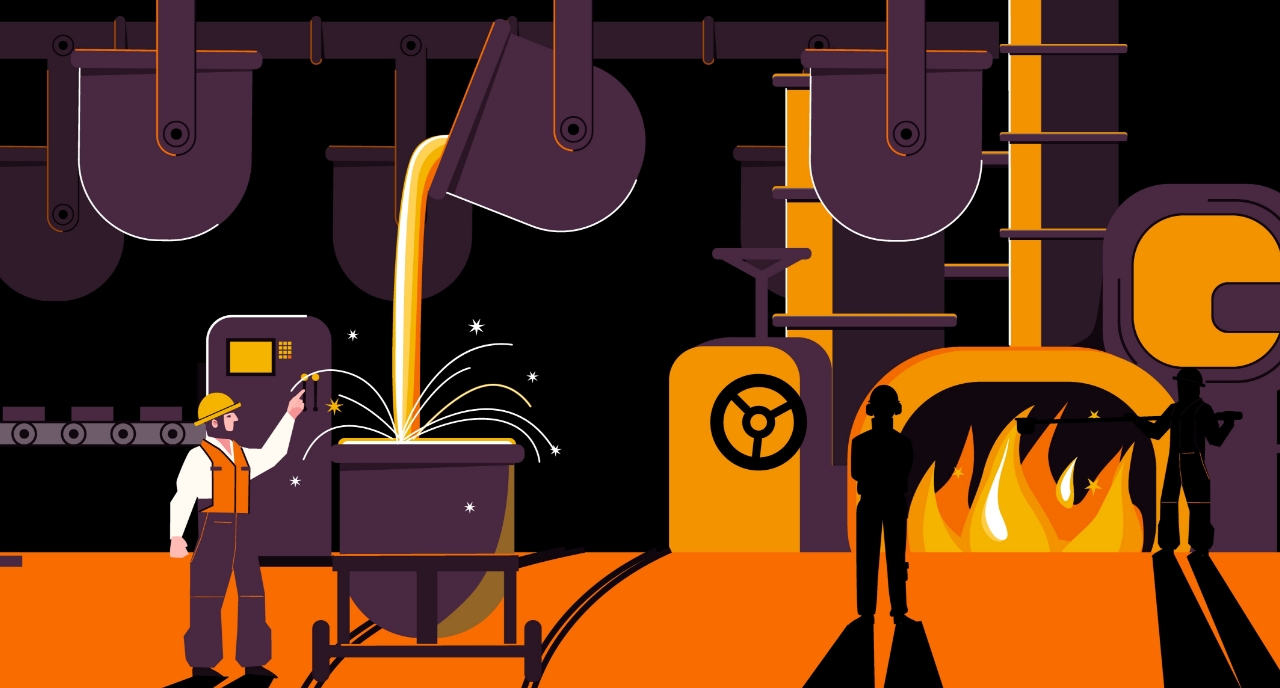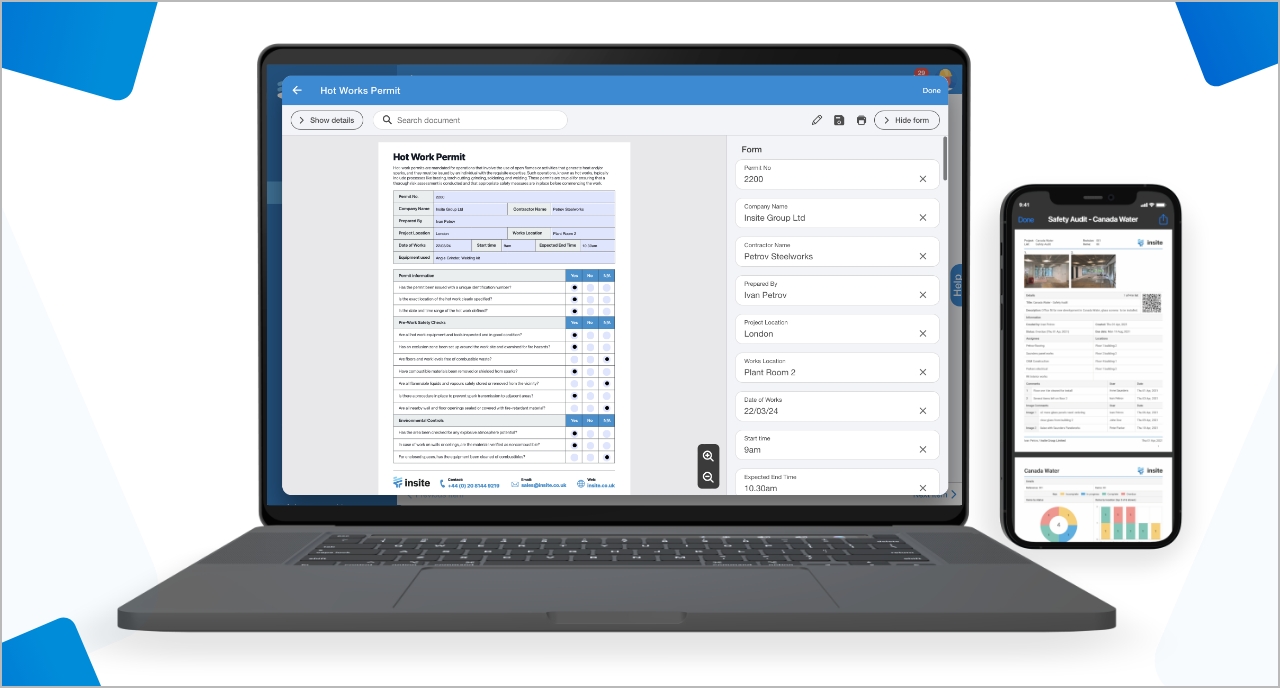Resources
Case studies
Videos
Sample reports
Free inspection templates
Learn
Blog
Product brochure
Training pack
Get the app
Download the app
Changelog
2024-03-24 | 8 min read
tags: Hot-Works Free-Template Insite
How to Ensure Construction Safety with the Right Hot Works Permit Template

Introduction
In the dynamic and often hazardous world of construction, safety is paramount. One critical aspect of maintaining a safe construction environment involves managing and mitigating risks associated with hot works. Hot works - including operations like welding, cutting, soldering, and brazing - pose significant fire and explosion risks if not properly managed. This blog delves into the essentials of hot works permits, offering guidance on how the right hot works permit template can significantly enhance safety on construction sites.

Understanding Hot Works Permits
What Are Hot Works Permits?
Hot works permits are formal documents that authorise individuals to perform activities that generate heat, flames, or sparks. These permits are not just bureaucratic paperwork; they are vital components of a comprehensive safety protocol, ensuring that hot works are carried out within a framework that minimises risk and promotes a safe working environment.
Types of Hot Works in Construction
Hot works encompass a broad range of activities, including but not limited to:
Welding: Joining metal parts using high heat.
Cutting: Dividing materials using tools like torches or saws.
Brazing: Joining metals by melting and flowing a filler metal into the joint.
Soldering: Joining small items with molten metal as a filler.
Each type of hot work comes with its own set of risks and requires specific safety measures, underscoring the importance of a detailed and customised hot works permit.
The Need for a Hot Works Permit
Potential Hazards of Hot Works
The primary hazards associated with hot works are fires and explosions. Sparks or molten materials can easily ignite flammable materials or gases, leading to potentially catastrophic outcomes. The risk is heightened in construction sites, where a variety of combustible materials and substances are often present.
Legal Requirements and Compliance
Beyond the obvious safety implications, there are legal and regulatory reasons for implementing hot works permits. Many jurisdictions require permits as part of workplace safety regulations, making compliance not just a matter of best practice but of legal necessity. Failure to comply can result in hefty fines and even suspension of work.
Case Studies Highlighting Incidents Due to Lack of Permits
Numerous incidents underline the critical importance of hot works permits. For instance, the 2014 fire in a Boston brownstone, which resulted in the death of two firefighters, was traced back to welding work that was conducted without a permit. This tragic event highlights not just the potential for loss of life but also the severe legal and financial repercussions for businesses that fail to adhere to hot works safety protocols.

Components of a Hot Works Permit Template
A comprehensive hot works permit template should serve as a roadmap for safely conducting hot works on construction sites. While the specific details may vary depending on the project’s nature and the regulatory requirements of the jurisdiction, several key components are universally critical:
Project Details
Project Name/Location: Identifies the specific site where hot works will be performed.
Date/Time: Documents when the hot works will take place, ensuring operations are only conducted during approved times.
Type of Hot Work
Description of the Work: A brief outline of what the hot work involves, including the specific type (welding, cutting, etc.).
Equipment Used: Lists the tools and machinery to be employed, which is crucial for assessing potential risks.
Safety Measures
Fire Prevention: Details on the preventive measures in place, such as removing flammable materials and ensuring fire extinguishers are at hand.
Protective Equipment: Outlines the personal protective equipment (PPE) required for workers involved in the hot works.
Authorisation
Permit Issuer: The name and signature of the person authorising the hot works, typically a safety manager or project supervisor.
Worker Acknowledgement: Sign-off by the individuals performing the hot works, confirming they understand and will adhere to the safety requirements.

How to Use a Hot Works Permit Template
Filling Out the Template
Conduct a Risk Assessment: Before any hot work begins, identify potential hazards related to the specific task and environment.
Complete Each Section: Fill out the template with attention to detail, ensuring all relevant information is included.
Review Safety Measures: Double-check that all required safety measures are not only listed but also implemented on-site.
Best Practices
Keep Records: Maintain a log of all issued hot works permits to track compliance and for auditing purposes.
Regular Training: Ensure all workers are trained in the risks associated with hot works and understand how to fill out and comply with the permit requirements.
Implementing Hot Works Permit in Your Project
Integrating hot works permits into your project planning isn’t just about documentation; it’s about fostering a culture of safety.
Integration into Project Planning
Pre-Planning: Incorporate hot works permit processing into the initial stages of project planning. This ensures all potential risks are assessed and mitigated before work commences.
Communication: Regularly communicate the importance of hot works permits and safety protocols to your team. This includes not only the workers directly involved in hot works but also all personnel on-site.
Training and Communication
Safety Training: Conduct comprehensive safety training sessions that cover the specifics of hot works safety and the proper use of the permit system.
Feedback Loop: Encourage feedback from workers on the permit process and safety measures. This can lead to improvements in safety protocols and worker compliance.
Regular Audits and Updates
Audit the Process: Periodically review and audit the hot works permit process to ensure it’s being followed correctly and remains effective.
Adapt and Update: Be prepared to update your hot works permit template and process based on feedback, changes in regulations, or after any incidents to improve safety continuously.

Digital vs. Paper Hot Works Permits
The Digital Advantage with Insite
Accessibility: Insite offers unparalleled access to hot works permits from anywhere, at any time. This boosts coordination and compliance across construction sites, ensuring all team members have immediate access to essential documents and safety protocols.
Real-Time Updates: With Insite, updates and communications about hot works permits are instant. This means every change or new requirement is immediately pushed to all relevant parties, ensuring everyone is working with the latest information and maintaining a high safety standard.
Easier Record-Keeping: Insite simplifies the management of hot works permits by digitising the entire process. This not only reduces paperwork but also makes it easier to track compliance, audit processes, and retrieve documents quickly for inspections, enhancing overall project efficiency.
Considerations for Paper Permits
Simplicity: In environments where technology access is limited, paper permits offer a straightforward, no-tech solution.
Immediate Physical Presence: Paper permits can be physically posted at the work site, serving as a visible reminder of the ongoing hot works and necessary precautions.
Choosing between digital and paper permits depends on the specific needs and capabilities of your project and team. Increasingly, the trend is moving towards digital for its efficiency and enhanced safety features.
Choosing the Right Hot Works Permit Template
Customisation Is Key
A template should be adaptable enough to suit the specific demands and safety requirements of each project. Look for templates that allow you to easily modify sections to reflect the nature of the hot works and the unique hazards of the construction site.
Scalability and Flexibility
Consider whether the template can scale with your project. As projects grow in complexity, the permit template should be flexible enough to accommodate new types of hot works and evolving safety protocols.
User-Friendliness
The template should be straightforward for your team to use, whether they are filling it out, reviewing it, or checking compliance on-site. Complicated templates can lead to errors or omissions that compromise safety.

Legal and Insurance Considerations
Navigating Legal Requirements
Hot works permits are often mandated by local or national safety regulations. Failure to comply with these regulations can lead to legal repercussions, including fines or stop-work orders. Your hot works permit template should therefore be designed to ensure full compliance with these legal requirements.
Impact on Insurance
Insurance providers may require evidence of hot works permit use as part of their policy conditions, particularly in industries where hot works are a common source of claims. Proper use of hot works permits can not only prevent incidents but also ensure that you are covered in the event of an accident.
Conclusion
The adoption of a well-designed hot works permit template is crucial for enhancing the safety and efficiency of construction projects. By opting for a template that is adaptable, scalable, and straightforward to use, you ensure your team adheres to the highest legal and insurance standards. Whether you choose the innovative digital permits or the traditional paper ones, the most important factor is the integration of the hot works permit process into your project planning and safety culture. This essential integration minimises the risks associated with hot works, leading to a safer, more productive construction site.
To elevate your project’s safety measures, we strongly recommend downloading our free hot works permit template. This template has been meticulously designed to meet the unique needs of your projects, supporting you in maintaining and enhancing safety standards. To download our free hot works permit template, please follow this link. We encourage you to make this template a key part of your safety protocols and to share your insights and outcomes with us. Together, we can make construction sites safer for everyone.
Get started with Insite
If you’re looking for a solution, Insite is here for you. Book a demo or sign up for a trial today. Get in contact for further information we’re here to help and will be happy to answer any questions you may have.